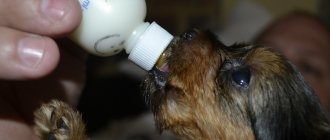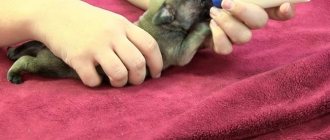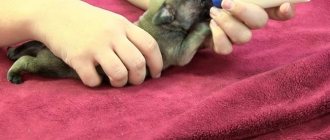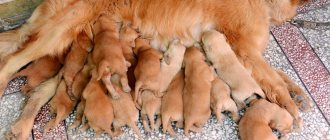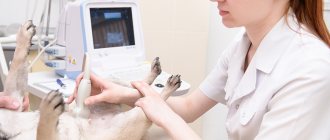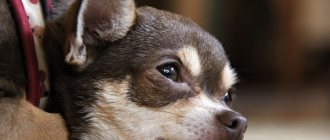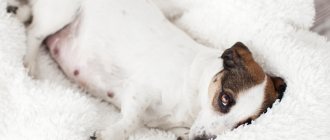Newborn puppies require special care, which increases their vitality. This applies to any breed, be it a Spitz, Yorkshire Terrier or Chihuahua. A person must prepare a nest where they will be in the first months of life. It is important to leave the bitch after giving birth so that her condition returns to normal. Correct behavior by the owner eliminates the risk of problems.
Newborn puppies
Caring for newborn puppies
The first thing the owner must prepare is a warm and dry nest where the bitch should give birth. It is advisable that it be in a separate room. When the puppies were born, the house must be made according to the following rules:
- select a cardboard box so that it does not feel crowded;
- the lid is cut off;
- The internal contents are covered with a mattress or film.
The temperature inside the house should be approximately 30 degrees. It is advisable to install an electric thermometer to maintain the temperature.
Features of development
Immediately after birth, features characteristic of newborns are distinguished:
- the first weeks, when the offspring is born, there is prolonged sleep;
- from the moment of birth, the offspring is deaf, blind, and lacks the ability to walk.
At 2 weeks your eyes should open. Initially they are blue, cloudy, then darken. It is necessary to keep the eyes clean, removing purulent discharge. The ear canals open on their own by 3 weeks.
At 4 weeks teeth appear.
But for each breed the period is individual. This leads to a limitation of breastfeeding; it is time to introduce complementary foods. Attention! Many people, when caring for newborn puppies, note that they shudder in their sleep; this is a normal reaction; voluntary muscle contraction occurs.
Breast-feeding
What to do after the birth of puppies
Not every owner knows what to do with puppies after birth. If they pass naturally, the person does not interfere. The babies are left near their mother and are provided with warmth and comfort. It is forbidden to separate them, this will worsen lactation and maternal instinct in the bitch. Babies should drink colostrum fluid, which contains antioxidants, proteins, vitamins, and immunoglobulins. This also applies to large breeds, such as the German Shepherd. Don't be afraid that she will run over the kids.
Additional Information! With rare exceptions, the newborn may not be active in sucking. To prevent his vital functions from deteriorating, artificial feeding with expressed milk or formula is used.
Licking puppies
Training and socialization of a puppy from 1 to 8 weeks
Puppies between one and three weeks old are still too young to respond to training or socialization.
By three to four weeks of age, they can see, hear, walk, and urinate/defecate on their own. Although their brains are still developing, they are capable of learning a thing or two.
Of course, it is still important for these young puppies to remain with their mother and littermates until they are eight to twelve weeks old.
Already at the age of three to four weeks, you can begin to put a box and begin basic litter training. Even if the puppies come home at eight to twelve weeks of age, you can begin to lay the foundation for training.
Four to seven weeks of age is an early window of socialization. Although the puppy must remain with its mother, it is now ready for new sights and sounds.
He should start dating people of all ages and appearances. This includes children who know how to handle dogs and will handle the puppy with care.
Newborn puppies: care in the first days of life
When the bitch begins to leave the den 3-5 days after giving birth, the owner needs to inspect the offspring.
- Trimming nails. Immediately after birth they are curved and sharp. This can cause harm if you move awkwardly.
- Inspection of stool. If a disease develops, they contain blood and pus.
- Check for dehydration. Lightly pinch the newborn's skin and release it. If there is no dehydration, it will quickly smooth out. Otherwise, additional soldering is required.
- Eye opening. From this moment on, it is necessary to secure the shelter so that the kids do not accidentally harm themselves when the puppies begin to walk on their own. Additionally, it may be necessary to remove pus if the dog does not lick it.
Interesting! Mostly mom does all the work. A person must ensure that the surrounding area is safe.
Rules for switching to dry food
A complete transition to dry food with abandonment of mother's milk is practiced at 2-2.5 months. Until this moment, the baby is introduced to the new product through feeding.
When to start feeding puppies dry food
The first acquaintance is organized from 3 weeks of life. The pet is given a pre-soaked starter and wet canned food. Feeding too early is useless, since the newborn’s stomach is adapted to only one type of food - mother’s milk. He simply cannot digest everything else.
Bitch after giving birth
Carefully examine the bitch after giving birth. Pay attention to the following criteria:
- there should be milk in the mammary glands, but there should be no stagnation, which increases the risk of mastitis;
- postpartum discharge should be free of blood and pus, which indicates pathology (dead puppy in the birth canal, bacterial infection);
- The dog’s body temperature is normal - 38-39 degrees, hyperthermia develops due to inflammation;
- behavior is stable, mother feeds and licks the puppies, warms them (aggression, anxiety, excessive weakness are a sign of illness).
If there are deviations in health, contact a veterinarian. Do not give medications on your own.
What to feed your dog to make it produce more milk?
If you don’t know how to increase milk in a nursing dog, you can give her milk with honey or Apilak tablets (one piece four times a day) as a drink. ... What to feed a nursing mother dog in the first month
- fish,
- meat,
- offal,
- cereals,
- dairy products and milk,
- vegetables.
24 Apr
2022 Interesting materials:
How to Unban a player on a Minecraft server? How to unlock the iPhone of a deceased person? How to unlock Android in blind mode? How to unlock abyss elves? How to unblock YouTube? How to unblock hidden accounts on Instagram? How to wake up the battery? How to split data in a cell? How to split a cell diagonally in Excel? How to split information in a cell?
If the dog does not feed the babies
If your dog gives birth, it is important to know what to do next. There are times when a bitch refuses to breastfeed. The owner must use artificial nutrition for the babies to survive.
What to feed
Veterinary pharmacies sell special mixtures to replace bitch milk. The following companies are used:
- Lactazor;
- Royal Canin Mini;
- Welpenmilch.
Each product comes with instructions for diluting the powder. You can use homemade ingredients if a similar mixture is not available:
- boiled goat milk;
- glucose solution in water;
- a mixture of milk and chicken yolk.
Professional breeders prefer to use a mixture that contains all trace elements, minerals, and vitamins.
How to feed
For feeding you will need a syringe with a rubber nozzle, a pipette, and a bottle with a small nipple. The mixture is given every 3 hours, it should be heated to 38-40 degrees.
How many
The newborn is pre-weighed to find out how much formula he will need. Usually 1 ml per feeding is enough to keep babies full. From 2 weeks the volume is increased to 10 ml.
Interesting! In the first week, puppies may lose weight, but this is normal.
How often
For healthy, strong puppies, feeding every 3 hours a day is sufficient. If they are low weight, the number of feedings is increased to every 1.5 hours.
Lure
In the first 3 weeks of life, breastfeeding is carried out. The owner must ensure that babies latch onto the nipple when eating. The first complementary feeding begins at 3-4 weeks. The following rules apply:
- small portions of food once a day, observing the baby’s reaction and feces;
- By week 6, add 1 more complementary food.
For newborn puppies, the following products are allowed to be added in small quantities:
- turkey meat, chicken, veal;
- eggs;
- dairy products;
- ocean fish without bones.
From 1.5 months, babies should eat 6 times a day in small portions. Three of them should be meat, the rest - dairy. After this point, cereals are added.
Feeding puppies and teaching them to independently consume food
From birth, puppies consume mother's milk, and in the absence of mother's milk, substitutes for mother's milk (it is recommended to use ready-made special formulas for puppies).
From 3 weeks of age, babies’ bodies are ready to digest meat and puppies can begin to be fed meat. Just like for adult dogs, the meat is not thermally processed. Scraped meat is prepared for puppies. You can do it in several ways. Scrape the frozen meat with a knife, grate the slightly thawed meat on a coarse grater, and grind into coarse mince. Puppies of this age are still fed milk by the mother, but the amount of milk gradually decreases, and additional food in the form of meat and dairy products is required. Since at this age puppies still feed on their mother’s milk, they are only introduced to meat, and then the amount of meat and dairy components is increased as breastfeeding decreases or stops altogether.
In order to teach a puppy to eat on its own, you need to pick up the puppy and lightly dip its muzzle into a bowl of milk or other dairy product, or meat, making it clear where the food is. A saucer is suitable as a dish, preferably with a wide base so that liquid food does not spill. Puppies very quickly understand what is required of them, become accustomed to such feeding and then eat on their own. By the age of one month, as a rule, puppies eat themselves, from a bowl placed on the floor. Do not try to feed from your hands more than necessary; puppies should immediately learn to eat from a bowl. Make sure that the puppies eat the food offered evenly if you have several puppies.
How to properly care for puppies in the first week of life
After the birth of the babies, the owner must monitor the behavior of the mother and newborns. She must cover them and provide access to breastfeeding. If this does not happen, the person warms up the box on his own and uses artificial feeding.
If the bitch has developed a maternal instinct, she performs further actions independently. With the help of licking, it removes amniotic particles, pus from the eyes, and stimulates the digestive tract. The owner must ensure peace, correct room temperature, and the availability of diapers.
Newborn blindness
How to wean babies off breast milk
At first, complementary feeding is combined with breastfeeding. Having aroused interest in new products, small pets begin to be fed separately. For serving, use flat plates from which you can easily take food. The amount of feed should be about 10% of the daily requirement.
The fed cubs are transferred to their mother and their behavior is observed. At first, they will have little interest in unfamiliar food and will be much more interested in suckling at the breast. Despite this, everything will change very soon.
“The easiest way to wean off is in a group. If at least one baby likes complementary foods, then everyone else will quickly follow suit.
If you defiantly ignore it, the softened and heated paste can be placed on the tongue or gently spread on the palate. Remember that your pets do not yet know how to eat on their own and they need your help even for such simple actions.
Avoid pressure. Forcing someone against their will will not bring the desired result, but will only slow down the process of weaning.
On average, weaning takes 2-3 weeks. During this time, the amount of feed is gradually increased from 10% to 100% of the daily requirement.
Proper care for puppies at 1-2 months
By this time, the babies began to move around and eat solid food. When puppies begin to defecate on their own, it is necessary to accustom them to a diaper so that they do not relieve themselves in other places. Mark a place for the toilet.
The amount of complementary foods is reduced to 3 times a day. They get vaccinated. The children are gradually taken outside. After this point, you can make documents for each puppy.
First feeding
Feeding Yorkshire puppies
Depending on the breed, the rules for introducing complementary foods may vary. This is especially true for miniature animals that are bred artificially. Tiny Yorkies quite often experience digestive problems. The stomach is often simply not able to digest the volume of food that the body needs due to its size. Therefore, special feeds are used for them, which, in a small volume, provide a good supply of nutrients.
Therefore, complementary feeding of a Yorkie puppy is most often carried out using soaked dry food “Starter Pappy”. Mash it with a fork until it becomes a paste. And when the kids grow up a little, they simply eat it soaked and wash it down with water. From two months you can switch to Mini Junior. Most breeders agree that this is the best feeding for Yorkies.
Behavior of puppies in the first few weeks after birth
Raising puppies from birth should be done in stages, according to rules, so that they remain healthy. Their behavior changes as they grow older, according to periods:
- 1 week - constant sleep;
- 2-3 weeks - eyes open, but the muscular frame is not strong enough to move around the entire territory;
- 4-6 weeks - babies move actively, consume breast milk and complementary foods, and can play with each other.
Attention! The owner must monitor whether there are weak individuals among the newborns. They require special care and frequent feeding.
Juvenile: 5–12 months
It is interesting to watch how puppies develop during adolescence. They are actively growing and gaining muscle mass. Dogs of toy and small breeds (for example, Yorkshire terrier, toy terrier, Chihuahua) reach maturity before the age of one year. But puppies of large breeds (for example, Labrador, Great Dane, Mountain Dog) become adults by 1.5–2 years, so they need more time to mature.
By 8 months, puppies' teeth and fur change. Boys are trying to mark their territory, and girls are entering their first heat period. From 4–5 months, the puppy learns to do its business outside. The more often you walk him, the faster this habit becomes established.
Between 6 and 12 months, the puppy experiences a second period of fear. His behavior changes dramatically, he begins to be afraid of new objects and even people well known to him. You should pet and calm your dog more often. Then your confidence will be transferred to her, and fear will disappear over time.
The juvenile period is a great time to train a young dog and teach it to come when called. Teach him not only new commands, but also the correct reaction to conflicts with other dogs. Excessive independence of a puppy often ends in attempts to escape from the owner. Manage to interest him in a game (with a stick, a ball), but do not punish him. The dog is sensitive to increased tone, so it is worth sticking to the golden mean in its upbringing. Everything connected with the owner should evoke only positive emotions in her.
By the age of one year, a Chihuahua is considered an adult dog. By this point, with proper development, the pet knows basic commands and is not afraid of people
Possible problems
Immediately after birth, problems may arise that the owner should pay attention to:
- one of the babies may turn out to be weak and underweight;
- refusal of the mother to breastfeed or the offspring;
- increased body temperature in the mother and babies, which may mean the development of complications and infectious diseases;
- suppuration of the eyes of the offspring;
- one offspring could be stillborn, but not emerge through the birth canal, which would cause a sharp deterioration in the dog’s well-being.
To resolve such problems, it is better to contact a veterinarian. He will accurately diagnose and prescribe treatment.
Pus and redness of the eyes
Immediately after the birth of pug puppies, Jack Russell, Yorkie, dachshund and other breeds, the owner must take care and care for them and the mother. It is important to use the first feeding correctly and observe the temperature regime. When puppies begin to walk after birth, it is necessary to fence off the den from dangerous objects. If preparation and subsequent care are carried out correctly, the babies will grow up quickly, each of them will be viable.
When do puppies start feeding themselves?
All the little dog needs is his mother's affection and milk. It contains all the necessary elements for the normal growth and development of the puppy. Mom feeds her babies as much as she can. Fourteen days after birth, some dog breeders begin to gradually introduce complementary foods.
When exactly to introduce new food depends on the condition of the puppy itself and how many there are in the litter. However, complete complementary feeding should not be introduced before he has teeth. This usually happens 20-30 days after birth. At this time, their mother begins to regurgitate incompletely digested food for her cubs, accustoming them to adult food.
Feeding recommendations
Complementary feeding for four-legged babies usually begins 21-30 days after birth. The first supplement to breast milk is regular milk, formula, or kefir. Feed the puppies, starting with one type of new food once a day. Gradually the number of times increases until breastfeeding is completely stopped.
From a month on, raw, well-chopped meat is introduced into the diet of a small pet. For the first complementary feeding from natural food, it is better to use beef scraps or minced meat. But it is better to use ready-made food Starter, which is recommended from 3 weeks of age.
By the age of two months, they themselves should eat meat food once a day, and dairy food several times a day. When there are more teeth, you can give him egg yolk, crackers, and drinking water. Then porridge, vegetables, and fish are added. A puppy also needs vitamins and minerals every day to be healthy.
Possible problems
With proper nutrition, puppies quickly gain weight, are active, and look healthy. In cases of overfeeding or undernutrition, problems with the gastrointestinal tract may occur. Indigestion and poor health can be caused by milk toxicity when the mother is sick or taking medication.
You should not give puppies sweets, a lot of salt, potatoes, pearl barley, spices, or fatty foods. These products are poorly digestible and negatively affect the digestive system. Teaching your pet to eat healthy food is important when he is still small.
Natural food or dry food?
Many owners of small pets are wondering what food is best to choose? Some argue that only natural food is suitable for a puppy. Others prefer dry food, which already contains all the necessary nutrients and nutrients. Mixing these two types of feeding is not recommended.
What should you consider when choosing store-bought food? Dry formula or canned food is produced separately for puppies, taking into account their age needs. Ready-made high-quality feed has a balanced composition, vitamins and mineral supplements. The ready-to-eat food granules themselves take care of your pet’s dental health. The main task is to choose a good food suitable for your dog.
Making a natural diet balanced is more difficult. This takes more time and effort; it is difficult to determine how much of the necessary vitamins and nutrients are in the prepared food. Approximately two-thirds of a four-legged baby’s diet should consist of protein foods. In addition to this, your pet needs to eat cereals, vegetables, and dairy products. The puppy should also receive a vitamin and mineral supplement every day.
